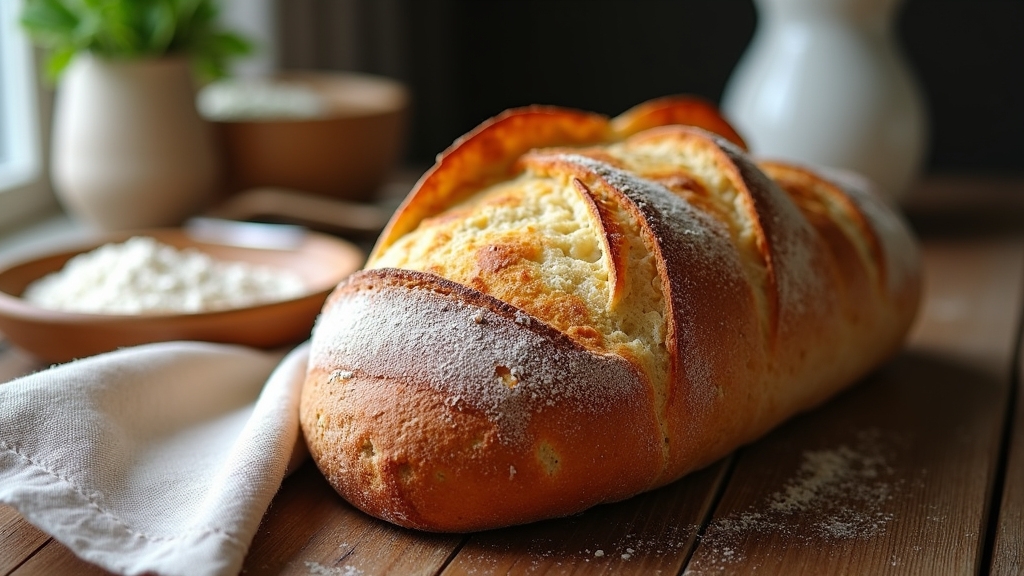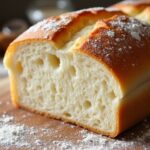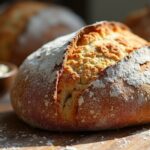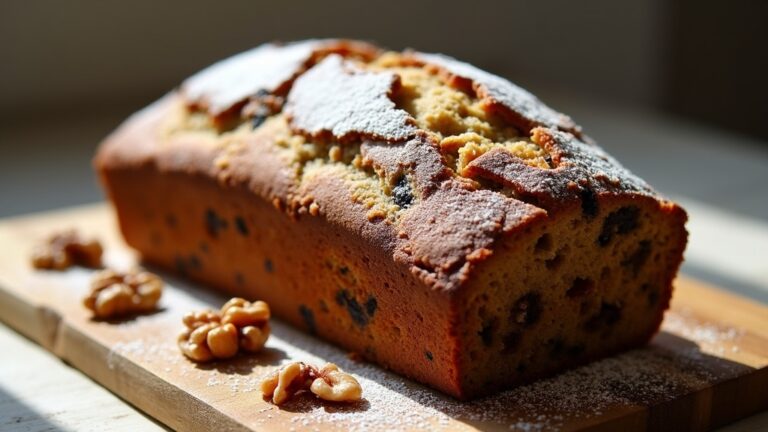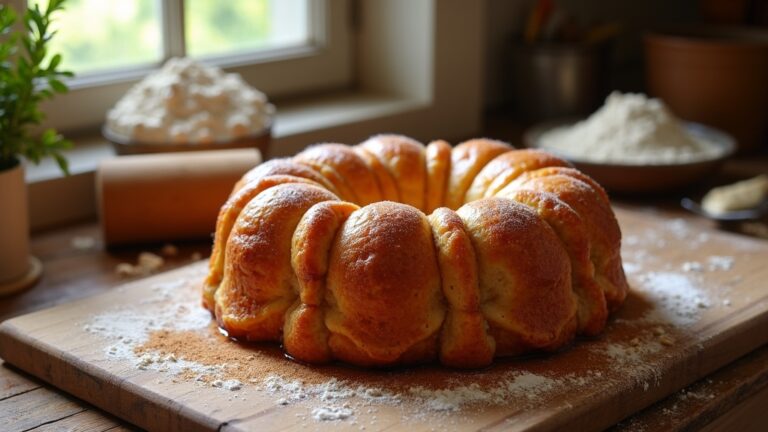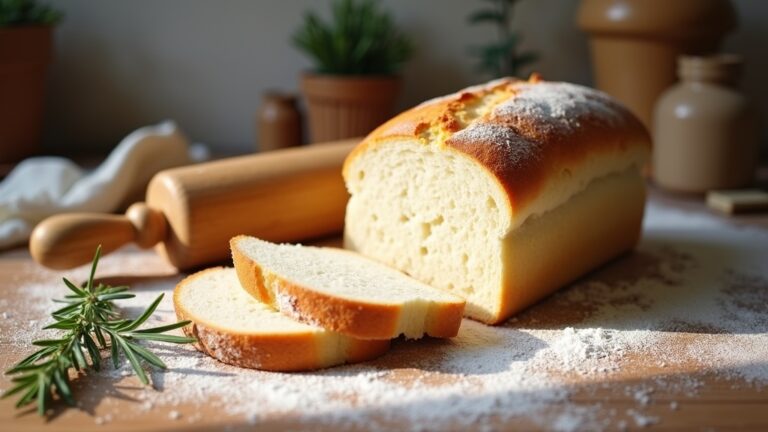Easy French Bread Recipe
To make simple French bread, I start by combining 1 packet of active dry yeast with 1 1/2 cups warm water (about 110°F) to activate the yeast. Next, I mix in 1 tablespoon of sugar and 2 teaspoons of salt, then gradually add 4 cups of all-purpose flour, stirring until the dough begins to form. I knead it on a floured surface until it’s smooth and elastic. After letting it rise until doubled, I shape it and bake at 425°F until golden. Trying different flours or adding seeds could further enhance your baking adventures.
Contents
History
French bread, with its iconic crust and soft interior, has a storied history that dates back centuries. Originating from French baking traditions, the secret to its allure lies in the simplicity and quality of its ingredients—flour, water, yeast, and salt. Mastery of these elements is paramount. Traditional techniques emphasize the importance of precise measurements and temperature control during fermentation. This process, known as proofing, allows the dough to develop its characteristic flavor and texture. Innovatively, these methods have been adapted over time to include variations in flour types and hydration levels, pushing the boundaries of what is understood as classic French bread while respecting its deep-rooted origins. Embrace these principles to grasp the essence of French bread.
Recipe
French bread, with its crispy crust and fluffy interior, is a beloved staple in many households around the world. Making it at home can be a rewarding experience, not only for the delightful aroma that fills your kitchen but also for the pleasure of creating something from scratch. This recipe simplifies the traditional techniques into manageable steps, making it accessible for bakers of all levels.
Discover the joy of baking French bread at home—simple steps for a delicious, crispy crust and fluffy interior.
The key to perfect French bread lies in the simplicity of its ingredients and the patience required during its preparation. The process involves letting the dough rise multiple times, which enhances the flavor and texture of the bread. By following this recipe, you will be able to bake a loaf that rivals those found in the best French bakeries.
Ingredients:
- 4 cups of all-purpose flour
- 1 tablespoon of instant yeast
- 2 teaspoons of salt
- 1 ½ cups of warm water (around 110°F)
- Cornmeal, for dusting
- 1 egg white, beaten with 1 tablespoon of water, for glaze
Begin by combining the flour, yeast, and salt in a large bowl. Gradually add the warm water to the dry ingredients and stir until a sticky dough forms. Turn the dough out onto a floured surface and knead for about 10 minutes, or until smooth and elastic. Place the dough in a lightly oiled bowl, cover with a damp cloth, and let it rise in a warm place until doubled in size, about 1 hour. After the first rise, punch down the dough and shape it into a long loaf. Sprinkle a baking sheet with cornmeal and place the loaf on top. Cover and let rise again until puffy, about 45 minutes. Preheat your oven to 375°F (190°C). Right before baking, slash the top of the loaf with a sharp knife and brush with the egg white mixture. Bake for 25-30 minutes, or until the loaf is golden brown and sounds hollow when tapped on the bottom.
When baking French bread, achieving the right texture is vital. Confirm your water is warm but not too hot, as extreme temperatures can kill the yeast, affecting the rise of your dough. Slashing the dough just before baking is not merely decorative; it allows the dough to expand freely, preventing it from bursting at undesired points. Finally, if you desire an extra crispy crust, try placing a small pan of water in the oven during baking, which creates steam and contributes to the crust’s development. Enjoy your homemade French bread as a side to your meals or as the base for delicious sandwiches!
Cooking Steps
Let’s start by preparing the yeast mixture; it’s essential for a good rise. You’ll need to dissolve the yeast in warm water with a pinch of sugar—this wakes up the yeast and gets it ready for action. Once it’s frothy, blend it into your flour and salt, then knead the dough until it’s smooth and elastic, setting the stage for a perfect French bread.
Step 1. Prepare Yeast Mixture
First, you’ll need to activate the yeast, which is vital for the bread’s rise. Begin by warming up 1 1/4 cups of water to about 110°F—this temperature is significant for ideal yeast activation without killing it. Pour the warm water into a large bowl and sprinkle in 2 1/4 teaspoons of active dry yeast. To guarantee the yeast dissolves completely, stir the mixture gently with a whisk.
Next, add a teaspoon of sugar to the mixture. This isn’t just for a hint of sweetness—it actually feeds the yeast, encouraging it to start working. Let this concoction sit untouched for about 10 minutes. You’re looking for a frothy, bubbly top, a clear sign your yeast is alive and ready to leaven your French bread.
Step 2. Knead the Dough
Once your yeast mixture is frothy, indicating that the yeast is active, add it to 4 cups of all-purpose flour in a large mixing bowl. Start by using a wooden spoon to combine the ingredients until you’ve got a shaggy mass. Now, dust your hands and work surface with flour—it’s time to knead. This step isn’t just about merging ingredients; it’s essential for achieving the right dough consistency. Employ a push, fold, and turn technique. Press down and away with the heels of your hands, fold the dough over, then give it a quarter turn. Repeat this for about 10 minutes. Your goal? A smooth, elastic dough that springs back when poked, setting the stage for perfect French bread.
Step 3. Let Dough Rise
After kneading the dough to a smooth, elastic consistency, it’s vital to give it time to rise properly. This phase, often called dough fermentation, is essential for developing flavor and texture. Place your dough in a lightly oiled bowl, ensuring all sides are coated to prevent drying. Cover the bowl with a damp cloth or plastic wrap to create an ideal environment for yeast activity.
Opt for a warm, draft-free spot to encourage best rising. The temperature should ideally be between 75°F and 85°F. Allow the dough to double in size; this usually takes about 1 to 1.5 hours. Avoid rushing this step, as proper fermentation is key to achieving a light, airy French bread with a delicious, complex flavor.
Step 4. Shape Into Loaves
Having allowed the dough to double in size, I’ll now guide you through shaping it into loaves, a step where precision shapes the final product. Here’s how to master the art of loaf shaping using innovative dough techniques:
- Divide the Dough: Gently deflate the risen dough. Then, divide it into equal portions—this guarantees uniform baking and perfect texture in every slice.
- Pre-shape the Portions: Roll each portion into a rough oval. Let them rest for a few minutes to relax the gluten, making them easier to shape.
- Final Shaping: Stretch and fold each piece lengthwise, sealing seams with a pinch. Roll gently to elongate into the traditional French bread shape, tapering the ends slightly.
This process will maximize your loaves’ aesthetic and texture.
Step 5. Bake the Bread
Preheat your oven to 475°F (245°C) before you slide the shaped loaves onto a lightly floured baking tray or into a well-greased French bread pan. This high temperature is essential for achieving that perfect crust—golden and crisp. To infuse a bit of innovation, try experimenting with steam. Just as you put the bread in, throw a few ice cubes onto the bottom of the oven. This creates a burst of steam that helps the bread rise better and forms a beautiful crust.
For bread variations, consider sprinkling different seeds or herbs on top before baking for added flavor and texture. This simple adjustment can transform your standard loaf into something uniquely delightful. Keep an eye on your bread and adjust baking times based on color and crispness.
Nutritional Guide
Understanding the nutritional content of this French bread recipe helps you make informed choices about your diet. Let’s explore the caloric content and ingredient benefits. Each serving of this bread provides a specific set of nutrients essential for your energy levels and overall health.
| Nutrient | Amount per Serving |
|---|---|
| Calories | 180 kcal |
| Carbohydrates | 36 g |
| Protein | 6 g |
| Fat | 1 g |
| Dietary Fiber | 2 g |
This table showcases the balanced profile of homemade French bread. Notice the moderate caloric content, which fits well into a variety of diet plans. The carbs fuel your day, while the protein supports muscle repair and growth. Incorporating whole grains could enhance these benefits, innovating the traditional recipe while boosting fiber content.
Final Thoughts
While exploring the nuances of this French bread recipe, I’ve shared how you can tailor it to boost its nutritional value. Now, let’s plunge into some final thoughts:
- Experiment with Grains: Try mixing in different flours like whole wheat or spelt for a deeper flavor and richer fiber content. This tweak not only enhances the nutritional profile but also introduces new textures to your bread.
- Incorporate Seeds: Add sesame, flax, or sunflower seeds into the dough. These not only offer a crunchy texture but also contribute healthy fats and minerals.
- Creative Flavor Twists: Don’t shy away from incorporating herbs like rosemary or thyme, or even a dash of garlic powder to elevate the taste.
Keep these baking tips and flavor variations in mind to make your French bread uniquely delicious!
Frequently Asked Questions
Can I Use Whole Wheat Flour Instead of All-Purpose Flour?
I’d recommend experimenting with whole wheat flour for its health benefits, though it’ll alter the bread’s texture. Mix it with all-purpose flour to maintain some lightness while gaining those whole wheat advantages.
How Do I Store Leftover French Bread to Keep It Fresh?
To keep your French bread fresh, wrap it in aluminum foil or a breathable cloth and store at room temperature. Avoid plastic as it traps moisture, softening the crust. Reheat briefly to restore crispness.
Is French Bread Vegan-Friendly?
Typically, French bread ingredients include flour, water, yeast, and salt, making it vegan-friendly. However, always check for additives like dairy in store-bought versions to confirm it aligns with vegan baking standards.
What Are Some Common Toppings or Spreads for French Bread?
I love layering luscious herb butter and generous garlic spread on French bread. Melt butter, mix with minced garlic, herbs, and season. Spread evenly for a flavorful, fragrant bite every time. It’s delightfully innovative!
Can French Bread Dough Be Frozen Before Baking?
Yes, you can freeze French bread dough before baking. Just wrap it tightly to avoid freezer burn. Thaw completely and let it rise again before popping it into the oven for fresh, home-baked bread.
Conclusion
After following this easy French bread recipe, you’ll feel as if you’ve been transported straight to a quaint Parisian bakery. Just imagine the golden crust and soft interior of your bread as akin to a warm embrace—comforting and inviting. This bread not only fills your kitchen with a delightful aroma but also offers about 8 grams of protein per serving. So, grab your apron and get ready to bring a slice of France into your home with each loaf you bake.
